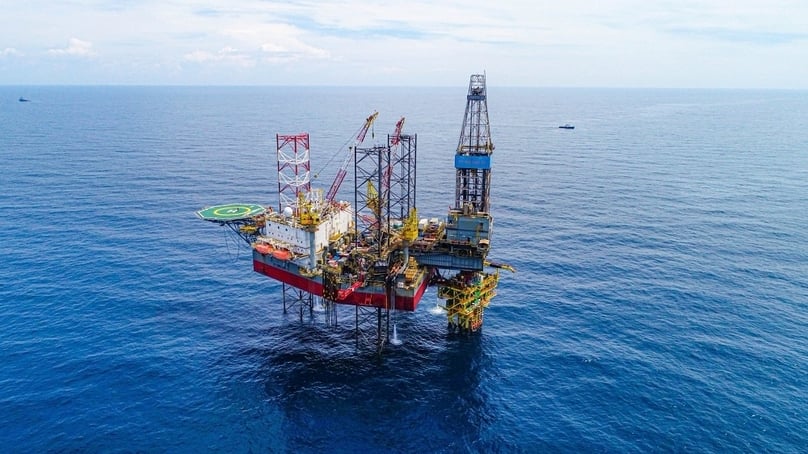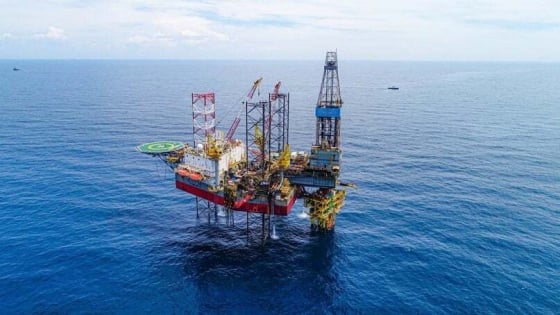By
Ngoc Diem, Thai Ha
Mon, November 17, 2025 | 8:57 am GMT+7
Stocks of Vietnam’s upstream oil and gas companies have surged in recent weeks, boosted by rising exploration activity and new rules that accelerate project approvals, while midstream and downstream players face pressure from falling crude prices.
The VN-Index has traded sideways between 1,600 and 1,700 points, but upstream stocks have sharply outperformed. Upstream activities involve the exploration and production of crude oil and natural gas, from finding the resources to bringing them to the surface.
PV Drilling (PVD) jumped 42% in under a month to a two-year high (from around VND19,000 on October 20 to VND27,000 or $1.02 per share), while PetroVietnam Technical Services (PVS) rose 24% over the same period (from VND28,400 on October 20 to VND35,200 per share).
Midstream players such as PVT and GAS posted modest gains, and downstream firms including BSR, PLX, and OIL mostly moved sideways.
PVT increased from VND16,600 a share to VND18,550 ($0.7), while GAS rose from VND56,000 to VND63,100 ($2.39).
A major catalyst came from the Government’s Resolution 66.6/2025, issued on October 28, which removes administrative bottlenecks in the oil and gas sector by delegating greater approval authority to state-owned Petrovietnam. The resolution is in force through February 2027.
Petrovietnam is now allowed to approve general field development plans, except for onshore fields or projects with integrated onshore-offshore facilities, and can sign off on certain investment adjustments, including changes of less than 10% in total capital costs, except for building additional oil rigs.
The shift is expected to shorten processing times and speed up upstream project execution, benefiting upstream firms such as PVD and PVS which involves exploration, exploitation, and related services.
Brokerage VNDirect said Vietnam’s upstream sector is entering a new investment cycle, recalling the boom period before 2015. A slate of new developments – Block B-O Mon (first gas 2027), Su Tu Trang phase 2B (2026), Dai Hung Nam, Kinh Ngu Trang-Kinh Ngu Trang Nam, Thien Nga-Hai Au, and Lac Da Vang – along with longer-term prospects such as Ken Bau and Nam Du-U Minh, will support multi-year demand for drilling, well services and field decommissioning as mature fields decline 15-20% annually.
 PV Drilling provides the PV Drilling VI rig for the Block B gas field development project in Vietnam. Photo courtesy of the company.
PV Drilling provides the PV Drilling VI rig for the Block B gas field development project in Vietnam. Photo courtesy of the company.
Upstream companies report strong earnings
PV Drilling said its rigs have been fully utilized amid rising regional drilling demand since the 2022 energy shock.
The company posted annual profits of VND600-700 billion ($26.57 million) in 2023-2024 and recorded a 46% increase to VND673 billion ($25.54 million) in the first nine months of this year, exceeding its full-year target by 27%.
PV Drilling’s prospects continue to be bright as demand for drilling rigs remains strong in international markets such as Indonesia, Malaysia, and Thailand; while Vietnam is also promoting large-scale upstream projects. All the seven rigs of PV Drilling have been contracted through 2026, with some secured until 2028.
PVS maintained annual profits above VND1 trillion ($37.95 million) in 2023-2024, with nine-month earnings up 34% to VND948 billion ($35.98 million) this year.
Viet Capital Securities (BVSC) said the company’s M&C (mechanical and construction) division is driving growth, supported by major awards from Block B, Lac Da Vang, and Su Tu Trang 2B since late 2024.
At Block B–O Mon, PVS has three EPCI packages worth over $1 billion in backlog, now underway to meet the scheduled first-gas target in Q4/2027. The company is also expanding into offshore wind construction, with around $2 billion in signed contracts expected to contribute significantly from 2025 to 2030.
PVS’s industrial construction projects also bring relatively positive prospects, especially from the energy conversion trend leading to increasing demand for investment in construction for LNG storage.
Midstream, downstream segments pressured by crude price declines
Midstream giant PV Gas (GAS) reported a 41% rise in Q3 revenue but flat profit of around VND2.5 trillion ($94.88 million), as falling LNG and LPG prices compressed margins despite higher LPG sales.
Downstream operators, however, benefited from more stable crude oil prices. BSR swung from a VND1.2 trillion ($45.88 million) loss to a VND909 billion ($34.5 million) profit in Q3, while Petrolimex posted a 5.4-fold increase to VND706 billion and PV Oil recorded a 3.8-fold rise to VND139 billion.
Brent crude slipped from $70.99 per barrel in July to $68.02 in September, but with narrower volatility than a year earlier. The relative stability supported downstream refining and distribution margins but hurt midstream players reliant on gas price spreads.
Oil prices have since become volatile again, dropping to $60 in mid-October due to escalating U.S.-China trade tensions before rebounding to $64. Firms fear renewed swings could weigh on full-year earnings.
VCBS expects Brent to trade between $62-68 per barrel in Q4, citing risks from tighter U.S.-China tariffs, OPEC+ supply increases, and lower geopolitical premiums following easing tensions around Gaza.
